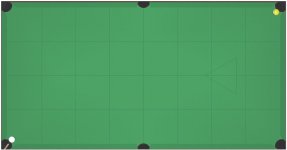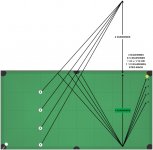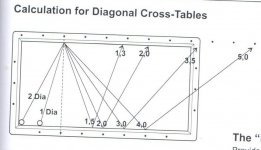You are using an out of date browser. It may not display this or other websites correctly.
You should upgrade or use an alternative browser.
You should upgrade or use an alternative browser.
The "Z" kick
- Thread starter Aaron_S
- Start date
heres is my 2 cents
first patrick i agree with you
your analogy of the 3 cb positions being stop frame pictures of the cue ball leaving the corner and going to the aim point on the first rail was a good one
all three balls are hitting the rail at the same angle so they should go to the same place on the second rail
neil a cue ball placed anywhere along the 6 diamond line(so width is 6 regardless of where on the line the cue ball is)
will give you the same offset
when you do the mirror image part and sight to different cue ball locations
you are going to get different points on the rail to aim at
ie if the cue bal was 1,2 or 3 diamonds off the rail but still on the 6 diamnd line
the reason you still get a 3 1/4
target with patricks example is because the line from the corner pocet to where you finger is on the cue stick to is on a straight line
so sighting to patricks cue ball gives to the same target
if you moved the cue ball up or down a diamond but still on the 6 diamond line you would have a different target
thats how i see it
first patrick i agree with you
your analogy of the 3 cb positions being stop frame pictures of the cue ball leaving the corner and going to the aim point on the first rail was a good one
all three balls are hitting the rail at the same angle so they should go to the same place on the second rail
neil a cue ball placed anywhere along the 6 diamond line(so width is 6 regardless of where on the line the cue ball is)
will give you the same offset
when you do the mirror image part and sight to different cue ball locations
you are going to get different points on the rail to aim at
ie if the cue bal was 1,2 or 3 diamonds off the rail but still on the 6 diamnd line
the reason you still get a 3 1/4
target with patricks example is because the line from the corner pocet to where you finger is on the cue stick to is on a straight line
so sighting to patricks cue ball gives to the same target
if you moved the cue ball up or down a diamond but still on the 6 diamond line you would have a different target
thats how i see it
Don't want to drag this out, but just this one more comment: Jimmy's system "aims at" the 2nd rail contact point when he does the double-distance measurement directly opposite the 2nd rail contact point.With Jimmys system, the second rail contact point doesn't even equate into the system.
Some day we can try it out together.
pj
chgo
It's a screenshot from Virtual Pool 3 - I use them all the time for my 3D drawings. It's great for generating 3D table/balls/stick, but it's really a game (a good one, with remarkably good physics for the most part).Pat, where are you getting your table diagram from?? Too bad WEI doesn't work on here anymore.
Yeah, I miss using the Wei table here. Guess Wei needs to drive some traffic to his website...
pj
chgo
P.S. Here's the VP3 screenshot I used for this thread (I added lines and text with a drawing program called SmartDraw.

Last edited:
Yes, and they all go to the same 2nd-rail target (1 1/2 diamonds step-back), but from different angles, so in fact all but one of the four shots below will miss the 1 ball and go long. Only the cue ball that starts on the near rail at the 6th diamond (#1 below) will hit the 1 ball, because it's the only one that's a true 6-diamond "width" shot....a cue ball placed anywhere along the 6 diamond line(so width is 6 regardless of where on the line the cue ball is)
will give you the same offset
when you do the mirror image part and sight to different cue ball locations
you are going to get different points on the rail to aim at
ie if the cue bal was 1,2 or 3 diamonds off the rail but still on the 6 diamnd line
The other three cue balls (#2, 3 & 4) are fractional "widths": #2 is 6.6 diamonds, #3 is 7.4 diamonds, and #4 is 8.4 diamonds - that's where they'd each be if projected back to the near rail on their correct kick tracks (not the tracks shown). I'm trying to devise a shortcut way of estimating "widths" for these middle-of-the-table cue balls.

By the way, on the 9-foot GCs with old, dirty cloth I play on this system works beautifully for 6-diamond and 4-diamond "widths" but goes a little long for 8-diamond "width" (all centerball with natural roll at pocket speed).
pj
chgo
Last edited:
Yes, and they all go to the same 2nd-rail target (1 1/2 diamonds step-back), but from different angles, so in fact all but one of the four shots below will miss the 1 ball and go long. Only the cue ball that starts on the near rail at the 6th diamond (#1 below) will hit the 1 ball, because it's the only one that's a true 6-diamond "width" shot.
The other three cue balls (#2, 3 & 4) are fractional "widths": #2 is 6.6 diamonds, #3 is 7.4 diamonds, and #4 is 8.4 diamonds - that's where they'd each be if projected back to the near rail on their correct kick tracks (not the tracks shown). I'm trying to devise a shortcut way of estimating "widths" for these middle-of-the-table cue balls.
View attachment 226486
By the way, on the 9-foot GCs with old, dirty cloth I play on this system works beautifully for 6-diamond and 4-diamond "widths" but goes a little long for 8-diamond "width" (all centerball with natural roll at pocket speed).
pj
chgo
thanks for your responce
:thumbup:
Interesting thread with a lot of good information. A question though.
Am I dreaming or do I remember a change to the BCAPL rules that says that a cue cannot be used as a measuring device now? If so, that would seem to rule out the cue measuring procedure for Jimmy's "double the distance" method.
Am I dreaming or do I remember a change to the BCAPL rules that says that a cue cannot be used as a measuring device now? If so, that would seem to rule out the cue measuring procedure for Jimmy's "double the distance" method.
Last edited:
You are thinking of the rule that you can not use any measuring device to check to see if a ball will fit through a gap. Here's the ruling on using your cue as it pertains to aiming with your cue (it's allowed)
1.3 Use of Equipment
Rule 1.3.1(c): Instances have been documented in which chalk that appears to be of a
compatible color actually appears as a contrasting color when it comes off on the cloth.
Chalk proven to cause this problem may be prohibited despite the initial appearance of
compatibility.
Rule 1.3.1(e): If two bridges are used, the upper bridge must rest on the head of the
lower bridge.
1. Situation: Player A lays their cue on the table to help line up a shot, then takes a
second cue in hand to assist as well.
Ruling: Foul. Only a single cue, held in the hand or not, may be used.
got it. thanks
You are thinking of the rule that you can not use any measuring device to check to see if a ball will fit through a gap. Here's the ruling on using your cue as it pertains to aiming with your cue (it's allowed)
1.3 Use of Equipment
Rule 1.3.1(c): Instances have been documented in which chalk that appears to be of a
compatible color actually appears as a contrasting color when it comes off on the cloth.
Chalk proven to cause this problem may be prohibited despite the initial appearance of
compatibility.
Rule 1.3.1(e): If two bridges are used, the upper bridge must rest on the head of the
lower bridge.
1. Situation: Player A lays their cue on the table to help line up a shot, then takes a
second cue in hand to assist as well.
Ruling: Foul. Only a single cue, held in the hand or not, may be used.
I believe that you cannot lay your cue on the table and let go of it and use it as a measuring device. This rule has been in effect for a long time.
I believe that you cannot lay your cue on the table and let go of it and use it as a measuring device. This rule has been in effect for a long time.
I think BCAPL at least has changed that rule to now allow you lay the cue on the table without holding it.
As near as I can tell, under WPA rules you must keep one hand on the cue. More added confusion.
6.12 Cue Stick on the Table
If the shooter uses his cue stick in order to align a shot by placing it on the table without having a hand on the stick, it is a foul.
Last edited:
Here's Jimmy Reid's system applied to the table-length z kick.
The path looks plausible to me, although it might go shorter or longer on dirty or new cloth.
View attachment 226181
The system only calculates the 2nd rail target - the 1st rail target is up to the shooter.
pj
chgo
Has anyone tried this and found it to be accurate? I tried it and found it to not be accurate. Not even close, in fact, with different CB - OB positions.
Did you read the whole thread? I made several posts about it's accuracy, and what affects it. It is accurate when you find out what works, and then translate that to all shots with it. By the same token, a little off with speed or spin or accuracy, and you will be way off by the end of the cb's run.
Going multiple rails requires great accuracy in every part of the equation to get accuracy at the end of the equation. Same with any other system out there. Also, there may be an adjustment like with any other system going from table to table. All that was not covered in a couple minute system sample that was shown.
i.e., it isn't even close to being accurate. Memorize the tracks and the adjustment that comes from experience will kick in and be much more accurate.
As I said in an earlier post, it's very accurate on the tables I play on (commercial Brunswicks with worn cloth) for shots covering up to about 2/3 table. More than that and it goes a little long.Has anyone tried this and found it to be accurate? I tried it and found it to not be accurate. Not even close, in fact, with different CB - OB positions.
You can't be careless about aim or sidespin, though.
pj
chgo
As I said in an earlier post, it's very accurate on the tables I play on (commercial Brunswicks with worn cloth) for shots covering up to about 2/3 table. More than that and it goes a little long.
You can't be careless about aim or sidespin, though.
pj
chgo
Your diagram > > > http://forums.azbilliards.com//attachment.php?attachmentid=226181 < < < illustrates the formula corner to corner.
I shot from one diamond up and one diamond to the right of the CB position in your illustration. It calculates almost a full diamond wide of the OB with next to non-existent sidespin coming right off the calculated 2nd rail target.
I do better with just intuition and past experience. This formula is just another attempt to make simple something which can't be made simple. It resembles aiming systems in that respect.
